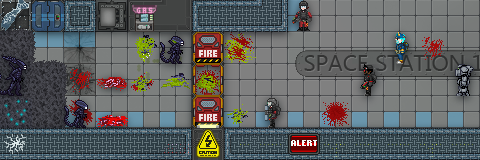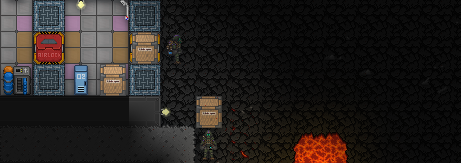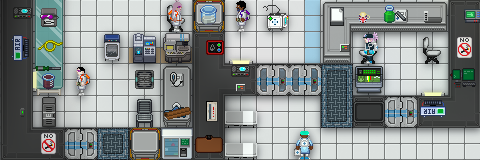User:Iatots: Difference between revisions
imported>Iatots (formatting is hard. also I hate float) |
imported>Iatots (copypaste code is bad mmmk) |
||
| Line 98: | Line 98: | ||
*The tablet is a pocket-sized supercomputer, capable of replacing most outdated computers still littering the station even with its moderate power. | *The tablet is a pocket-sized supercomputer, capable of replacing most outdated computers still littering the station even with its moderate power. | ||
Just like a normal computer, every frame requires a power supply, processing unit, drive and of course, programs to run. Programs can be downloaded from the NET as long as you have a network card installed. If for some reason you do not, or the quantum relay is off, you can install directly from disks. Simple network cards will have some signal [[File:low_signal_tiny.png]] and work only on station and lavaland, while better cards will have good signal [[File:high_signal_tiny.png]] on station/lavaland and then some [[File:low_signal_tiny.png]] even in space! There even exist straight up ethernet connections for the console, though it's not clear exactly where the plug comes from on an asteroid. | Just like a normal computer, every frame requires a power supply, processing unit, drive and of course, programs to run. Programs can be downloaded from the NET as long as you have a network card installed. If for some reason you do not, or the quantum relay is off, you can install directly from disks. | ||
Simple network cards will have some signal [[File:low_signal_tiny.png]] and work only on station and lavaland, while better cards will have good signal [[File:high_signal_tiny.png]] on station/lavaland and then some [[File:low_signal_tiny.png]] even in space! There even exist straight up ethernet connections for the console, though it's not clear exactly where the plug comes from on an asteroid. | |||
{|class="wikitable floatright" style="text-align: center;" | {|class="wikitable floatright" style="text-align: center;" | ||
| Line 239: | Line 241: | ||
|- | |- | ||
|Network card | |Network card | ||
| | |[[File:low_signal_tiny.png]] | ||
|style="background: green;"| | |style="background: green;"| | ||
|style="background: green;"| | |style="background: green;"| | ||
| Line 246: | Line 248: | ||
|- | |- | ||
|Advanced network card | |Advanced network card | ||
| | |[[File:low_signal_tiny.png]]/[[File:high_signal_tiny.png]] | ||
|style="background: green;"| | |style="background: green;"| | ||
|style="background: green;"| | |style="background: green;"| | ||
| Line 253: | Line 255: | ||
|- | |- | ||
|Wired network card | |Wired network card | ||
| | |[[File:high_signal_tiny.png]] | ||
|style="background: green;"| | |style="background: green;"| | ||
|style="background: red;"| | |style="background: red;"| | ||
| Line 287: | Line 289: | ||
|style="background: cyan;" colspan="2" | 100 | |style="background: cyan;" colspan="2" | 100 | ||
|- | |- | ||
|} | |||
Revision as of 12:31, 12 February 2017
-
A xenomorph infection.
-
Miners setting out to get minerals.
-
A normal shift in Chemistry.
About SS13Space Station 13 is a paranoia-laden roleplaying game set against the backdrop of a nonsensical, metal death trap masquerading as a space station. Read more here.
/tg/station 13 CommunityMain website for the /tg/station13 community is http://tgstation13.org
ServersThere are currently two /tg/station13 servers, both hosted by MrStonedOne. Sybil and Bagil operate /tg/station13 code.. Download BYOND to play. Sybil: <byond server=game.tgstation13.org port=1337>byond://game.tgstation13.org:1337</byond> Alternative MapsCheck out these alternative maps that come packaged by default in the game. |
<tab name="Modular Computers">
"Modular Computer" refers to those electrical devices designed with ease of assembly and upgrading through the use of special "modular" components. These components are housed in frames of which there are three types, each offering different advantages.
- The console is a static structure, and can house the most powerful components, as well as a wired connection to the network.
- The laptop is a compromise between portability and power, capable of all but the most intensive operations in exchange for its mobility.
- The tablet is a pocket-sized supercomputer, capable of replacing most outdated computers still littering the station even with its moderate power.
Just like a normal computer, every frame requires a power supply, processing unit, drive and of course, programs to run. Programs can be downloaded from the NET as long as you have a network card installed. If for some reason you do not, or the quantum relay is off, you can install directly from disks.
Simple network cards will have some signal ![]() and work only on station and lavaland, while better cards will have good signal
and work only on station and lavaland, while better cards will have good signal ![]() on station/lavaland and then some
on station/lavaland and then some ![]() even in space! There even exist straight up ethernet connections for the console, though it's not clear exactly where the plug comes from on an asteroid.
even in space! There even exist straight up ethernet connections for the console, though it's not clear exactly where the plug comes from on an asteroid.
the programs
DEFAULT
Ntdownloader (4)
Download more programs from the NET. Some programs are locked behind certain ID accesses.
File browser (8)
Manage files, create text files.
Configuration (4)
Manage processes, programs or components of your frame.
THE NET
Ntnrc_client (8)
An IRC client. While you might think it more private than PDA messages, the RD (or anyone with his access) is the sysADMIN for this, meaning they can see who logs when, and probably enter password-protected channels forcefully.
Nttransfer (7)
A peer-to-peer file transfer system.
Ntmonitor (12)
Monitor the NET itself, requires RD access.
Can shut down various NET functions separately such as IRC, downloader, P2P file transfer and station-bound functionalities, or just the whole thing.
STATION EQUIVALENTS
Power Monitoring (9)
Monitor the power output from SMES, see what APC is charged and connected. Same as power monitoring console.
Alarm (5)
Monitor where air alarms on the station go off. Same as air alarm console.
Ai restorer (12)
Restore an AI that was critically damaged. Same as AI restorer console in the RD's office.
identification card authentication module (8)
Read and modify access on IDs, open and close job position. Same as ID machine in HoP's office.
SYNDACATE
These programs would be moderately useful, if only anyone relied on the NET.
DoS traffic generator (20)
Launches a DoS attack on a NET's quantum relay. Relies more on connection quality than processing power.
Revelation (13)
This program, once run, fries a computer's inner drives and PSU with a moderate shower of sparks. Its biggest strenght is being able to change its name to anything and allow for acts of delayed sabotage.













